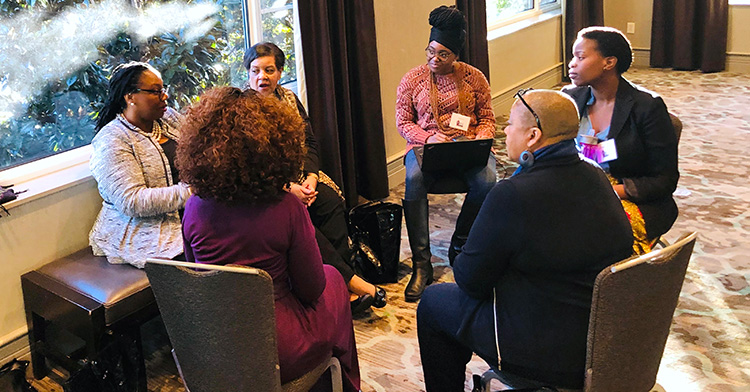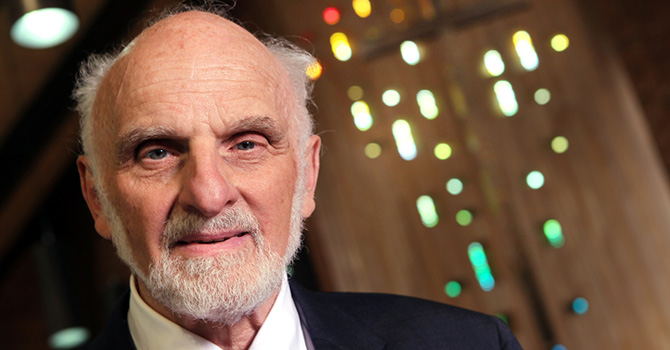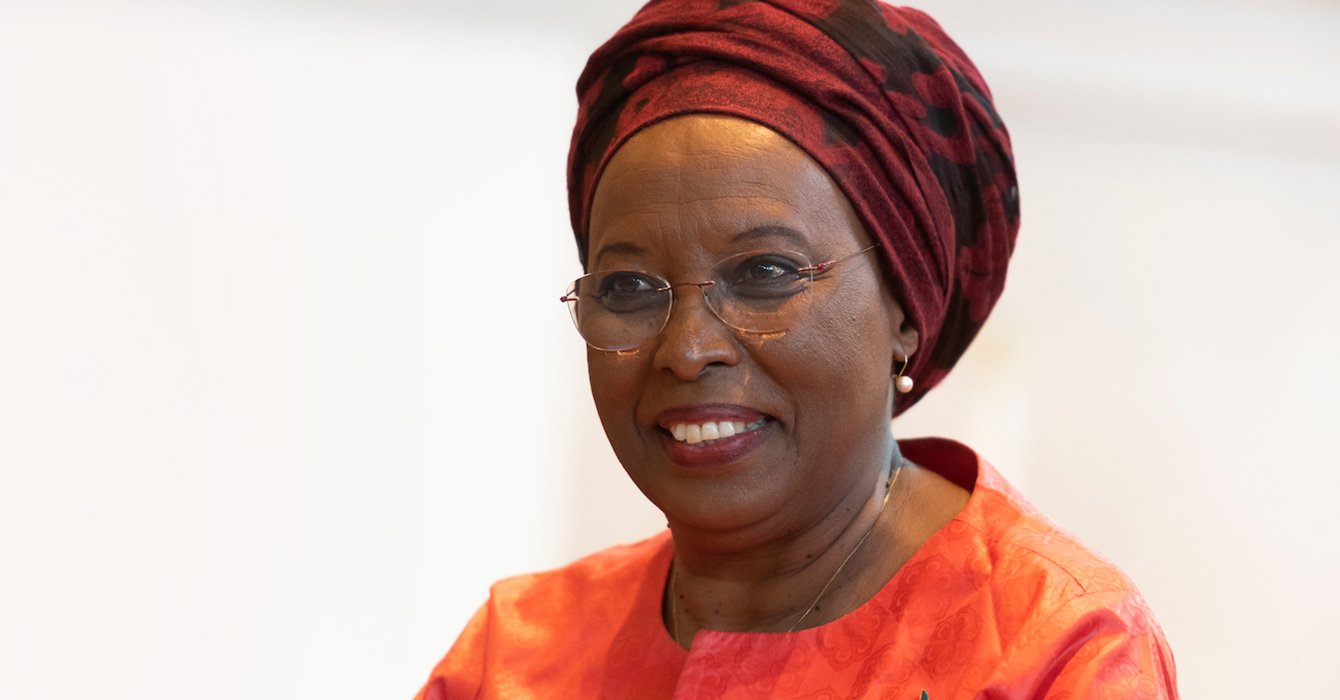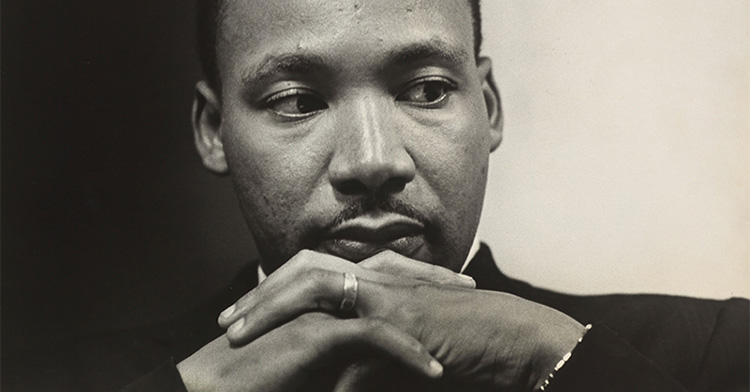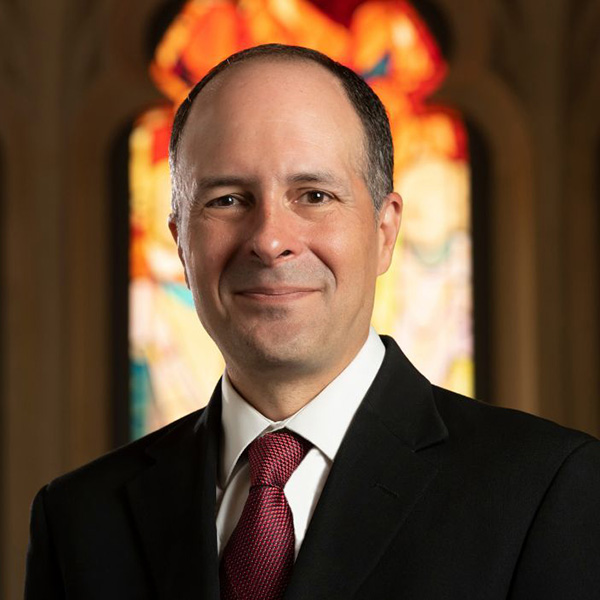Update: Lisa L. Thompson is associate professor and the Cornelius Vanderbilt Chancellor Faculty Fellow of Black Homiletics and Liturgics at the Divinity School and Graduate Department of Religion of Vanderbilt University.
You can read the Bible through and you will never find anything about guns or gun violence. But Scripture is rich with resources that speak to those issues, says Lisa L. Thompson, assistant professor of homiletics at Union Theological Seminary.
“It’s not going to have a verbatim answer, but if we read the text, there are principles that come up over and over. One of those is violence, and how we connect and live with one another,” she said.
Part of the task of preaching about gun violence is to draw upon texts that illustrate God’s disposition toward violence and the sanctity of life and human dignity, she said.
“If the text, and our faith, values life -- the sanctity of life, the imago Dei in every individual -- then somehow that has to hit the ground today,” she said. “If we say that gun violence leads to disregard for human life and dignity and does not recognize the image of God in every person because it takes life away so carelessly, then we begin talking about gun violence as people of faith.”
Thompson was a featured speaker last fall at “God and Guns: Faith Leaders Address Gun Violence,” a conference at The Riverside Church in New York. She and the Rev. Amy Butler, senior minister at Riverside, co-led a session on "How to Preach and Teach on Gun Violence." An ordained Baptist minister, Thompson has a Ph.D. and an M.A. in religion from Vanderbilt University and an M.Div. from Fuller Theological Seminary.
Before joining the faculty at Union, she was an assistant professor of homiletics at Pittsburgh Theological Seminary in Pittsburgh, Pennsylvania, and a Lilly Faculty Fellow at McCormick Theological Seminary in Chicago.
Thompson’s publications include “‘Now That’s Preaching!’ Disruptive and Generative Preaching Practices,” in Practical Matters Journal, and “In Search of Our Mothers’ Healings: Holistic Wellbeing, Black Women and Preaching,” in Homiletic, The Journal for the Academy of Homiletics. Her forthcoming book is entitled “Sacred Imaginings: Black Women and the Practice of Preaching.”
She spoke recently with Faith & Leadership. The following is an edited transcript.
Q: So how does one preach and teach about gun violence?
The hope in preaching is that at some level, the message lands in the lives of the listeners and connects in terms of what I call contemporary veracity -- it holds true today in a way that it has implications.
Traditionally, we use illustrations, images and metaphors to touch and make bridges and connections between the message and the listeners, so we have to reframe gun violence. One thing that I always go back to is that this is not just about gun violence.
We have to think about our approach to Scripture. If we were to mine it for matters related to this issue of gun violence, there are some key things there. There are ideas around violence and connection, our relationship to neighbor and others, and how this connects to our relationship with God and our belief and understanding of Christianity.
If you go to Scripture, you’re not going to see anything about gun violence. It’s not going to have a verbatim answer, but if we read the text, there are principles that come up over and over. One of those is violence, and how we connect and live with one another.
One thing that we have not done well -- and sometimes are even afraid to do -- in our congregations and pulpits is to tackle biblical texts that are violent. And this is also why we hesitate to talk about gun violence -- we haven’t figured out how to talk about violence, and violence in Scripture. Talking and teaching about gun violence has to begin with our willingness to tackle texts in the Bible that are violent.
We can’t say that guns exist in the Bible, but we can think about parallels between how we interpret violent texts, or how we interpret God’s disposition toward violence and the sanctity of life and human dignity. Those are things we can talk about and make parallels to what we do today.
If the text, and our faith, values life -- the sanctity of life, the imago Dei in every individual -- then somehow that has to hit the ground today. If we say that gun violence leads to disregard for human life and dignity and does not recognize the image of God in every person because it takes life away so carelessly, then we begin talking about gun violence as people of faith. We can then work backward to say, as people of faith, that this might be something we need to tackle. Does it resonate with our core beliefs as people of faith?
Q: Are there particular scriptures that are useful in that interpretation?
I think about the narrative of creation, where we see God breathe into adam and creation is called good and the human being is called good. Then if we go back to the commandments, “Thou shalt not kill” is there for a reason. It dictates how we are in relationship one to another but also says something about the value of life.
And if we look beyond texts in general, if we look at the ministry of Jesus, it was fundamentally about attending to the people in his midst, sitting with everyone, meeting the needs, feeding. Feeding was not just a spiritual practice; the body needed nourishment. The body was valued. The person was valued as a whole person.
The echo behind this idea of gun violence is that something is at stake. It’s curious that we talk about gun violence and we’re not just speaking about gun rights. This is the way that you frame the conversation, which says, “There is something there.”
Q: Speak some to that -- the distinction between talking about gun violence and talking about gun rights. I can have a right to own guns, but it’s a different question to say, “Do I have a right to gun violence?”
That’s the way that we often hear the conversation in the media and on political platforms. When the conversation of gun violence comes up, the pushback is the idea of gun rights, and those are two different things.
At the end of the day, the question about gun rights isn’t whether or not someone can own a gun. It is just what you said. Is there a right to gun violence? And then, what is the responsibility that we have in even claiming the right to own a gun as a nation or individually?
There are lots of Christians in our nation who are adamant about gun rights and being able to carry their guns, so that any infringement on that seems like a threat. But part of the key to working across difference -- and where preachers have missed the mark -- is to translate what happens in the public square into the theological narrative.
For me, that means we have to figure out how to say why this matters to people of faith. What does it have to do with life? What does it have to do with faith? What does it have to do with our lives and our relationship with God?
This is where we miss the point in the pulpit -- the divide that happens in the message because we are not able to help people of faith translate between faith and everyday life. We tend to distance that stuff out there in the world, as though we do not have to be close to it.
Q: So how do clergy do that?
I always say that if we are not attentive to the world in which we live, then our sermons will not be attentive to the world in which we live.
Do we read the news? Do we watch the news?
Pick up a newspaper. Watch the news. Be in conversation with people who are different from you and might not have the same perspective.
We do that also reading the text. In the classroom, I always say that in the first reading of the text, before you even get to thinking about the sermon, just let the free association flow. It’s amazing what happens when we’re reading something and all the connections are happening in our mind that sometimes lay dormant or are elusive, beneath the surface.
If I read something -- I don’t know, say, “the Ammonites went in and possessed the land, and they destroyed all the inhabitants of the land” -- if I’m reading that attentively without just thinking that I know the answer to the text, something happens when I hear “destroy.” There are associations in my mind with “destroy” and “land.”
“Well, wait, people were in the land? So does this mean that the people were killed? And what are the implications of that?” There’s a way where I think we have to let the text jar us, and that happens as we read it closely, and it’s what shakes us from the world in which we live.
Q: Many people now are trying to figure out the role of clergy in talking about political issues. Gun violence and gun rights are clearly political issues, but are they also more than that?
It is absolutely political. But I’m not sure how we’re not supposed to get political when it’s the world in which we live. If we look at the Bible, our sacred texts are political. From the beginning, they are about trying to figure out life as people of faith and interacting with other people.
Then if we go to the Gospels, if Jesus wasn’t political, I don’t know who was political. When you say, “The kingdom is at hand” in the middle of the Roman Empire, that is a political statement. That’s a statement about this kingdom that Jesus is speaking about and the literal kingdom of the empire. The turning over of the tables of the money exchangers in the temple -- all of that is political.
It’s just a matter of our willingness to read it that way, even down to the crucifixion of Jesus, which I’ll even call an execution. The gospel is political at heart.
Q: How do clergy help their congregations think critically about all of this and about gun violence?
One approach is taking the long-term view in preaching and teaching. Change does not happen overnight, so I always suggest to preachers that they think about, “What are the hopes for your ministry over the long term?” Every congregation is shaped by what it hears over time. This is how we develop our values. Over time, the narrative that comes from the pulpit and the Christian education ministries shapes the values in the congregation. This is a long-term change. We take it small steps at a time, and we need to think about it that way.
Another way is to think about that underlying narrative that I spoke about earlier, the underlying narrative in all of our sermons. If we say we value life, then we need to think about how we preach the value of life over the long term and teach about the value of life in our congregations and context.
The third way I want to think about is, how do we teach in the midst of resistance? In preaching and teaching, there’s always going to be resistance or obstacles to the message being received.
If it’s a congregational context that says, “It’s my right to own my shotgun or my rifle or my M16” -- OK, fine. It’s your right to own it.
But is there a way that the preacher can find something that his or her listeners can agree with, where you can draw a parallel? If somehow in the sermon you’re able to get people on board to say, “Oh yes, we value life, and God values life, so we have the responsibility to take care of life and to take care of one another” -- if they can say yes to that, then the preacher may be able to introduce, “Well, look at this tragedy. A young boy was taken by gun violence, by a random drive-by or a domestic-violence incident.”
It’s about figuring out how to create parallels for people where there is resistance. What can they not disagree with? If we can get them to say, “Yes, I cannot disagree with that,” then by the time we get around to the tough thing that is really the same thing, they’ll also say, “Oh, yeah. That too.”
Q: You’ve written about “disruptive and generative preaching.” Isn’t that what all sermons should be about?
It is, but then we have to also recognize that every disruption is not generative. Does it help the community thrive in its life together in ways that continue to foster life more abundantly? Sometimes, we can do things that can be disruptive in the preaching that do not lead to the well-being of the congregation.
In teaching these tough topics, those of us who go and get all sorts of education and knowledge around texts know there are plenty of things we can make Scripture do if we decide to preach it. At the same time, the question on the other side of that is, “How do I do the least harm even as I tackle these tough topics?”
Because we’re not just tackling a text. We’re tackling a text that has authority in the community and the community’s way of life.






